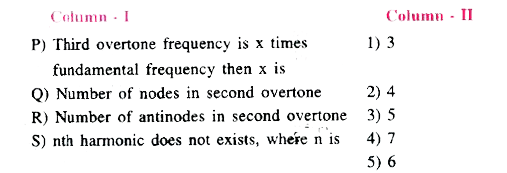An organ pipe is closed at one end has fundamental frequency of 1500 Hz. The maximum number of overtones generated by this pipe which a normal person can hear is
14
13
6
9
The correct Answer is:C
To solve the problem of determining the maximum number of overtones generated by an organ pipe closed at one end with a fundamental frequency of 1500 Hz, we can follow these steps:
Step 1: Understand the Overtone Frequencies
For an organ pipe closed at one end, the frequencies of the harmonics (overtones) are given by:
- Fundamental frequency (1st harmonic): f1=f
- First overtone (3rd harmonic): f2=3f
- Second overtone (5th harmonic): f3=5f
- Third overtone (7th harmonic): f4=7f
- And so on...
Step 2: Identify the Fundamental Frequency
The fundamental frequency f is given as 1500 Hz.
Step 3: Determine the Frequency Range of Human Hearing
A normal human can hear frequencies from 20 Hz to 20,000 Hz (20 kHz). Therefore, we need to find the maximum overtone frequency that is less than or equal to 20,000 Hz.
Step 4: Set Up the Inequality
The frequency of the nth overtone can be expressed as:
fn=(2n−1)f
where n is the number of overtones. We want to find the maximum n such that:
fn≤20,000 Hz
Substituting the fundamental frequency:
(2n−1)×1500≤20,000
Step 5: Solve the Inequality
1. Rearranging the inequality:
2n−1≤20,0001500
2. Calculate 20,0001500:
20,0001500=20015≈13.33
3. Now, we have:
2n−1≤13.33
4. Adding 1 to both sides:
2n≤14.33
5. Dividing by 2:
n≤7.165
Step 6: Determine the Maximum Integer Value of n
Since n must be an integer, the maximum value of n is 7.
Step 7: Calculate the Number of Overtones
The number of overtones is given by n−1 (since the first harmonic is the fundamental frequency). Therefore:
Number of overtones=n−1=7−1=6
Final Answer
The maximum number of overtones that can be generated by the pipe, which a normal person can hear, is 6.
---
For an organ pipe closed at one end, the frequencies of the harmonics (overtones) are given by:
- Fundamental frequency (1st harmonic): f1=f
- First overtone (3rd harmonic): f2=3f
- Second overtone (5th harmonic): f3=5f
- Third overtone (7th harmonic): f4=7f
- And so on...
The fundamental frequency f is given as 1500 Hz.
A normal human can hear frequencies from 20 Hz to 20,000 Hz (20 kHz). Therefore, we need to find the maximum overtone frequency that is less than or equal to 20,000 Hz.
The frequency of the nth overtone can be expressed as:
fn=(2n−1)f
where n is the number of overtones. We want to find the maximum n such that:
fn≤20,000 Hz
(2n−1)×1500≤20,000
1. Rearranging the inequality:
2n−1≤20,0001500
2. Calculate 20,0001500:
20,0001500=20015≈13.33
3. Now, we have:
2n−1≤13.33
4. Adding 1 to both sides:
2n≤14.33
5. Dividing by 2:
n≤7.165
Since n must be an integer, the maximum value of n is 7.
The number of overtones is given by n−1 (since the first harmonic is the fundamental frequency). Therefore:
Number of overtones=n−1=7−1=6
The maximum number of overtones that can be generated by the pipe, which a normal person can hear, is 6.
Topper's Solved these Questions
- SUPERPOSITION AND STANDING WAVESBOOK - CENGAGE PHYSICS ENGLISHCHAPTER - SUPERPOSITION AND STANDING WAVESEXERCISE - Multiple Correct Answers Type
5 Videos
- SUPERPOSITION AND STANDING WAVESBOOK - CENGAGE PHYSICS ENGLISHCHAPTER - SUPERPOSITION AND STANDING WAVESEXERCISE - Fill in the Blanks Type
34 Videos
- SUPERPOSITION AND STANDING WAVESBOOK - CENGAGE PHYSICS ENGLISHCHAPTER - SUPERPOSITION AND STANDING WAVESEXERCISE - Integer
9 Videos
- SOUND WAVES AND DOPPLER EFFECTBOOK - CENGAGE PHYSICS ENGLISHCHAPTER - SOUND WAVES AND DOPPLER EFFECTEXERCISE - Integer
16 Videos
- THERMODYNAMICSBOOK - CENGAGE PHYSICS ENGLISHCHAPTER - THERMODYNAMICSEXERCISE - 24
1 Videos
Similar Questions
In closed organ pipe at one end-

View SolutionA closed organ pipe has a fundamental frequency of 1.5 kHz. The number of overtones that can be distinctly heard by a person with this organ pipe will be : (Assume that the highest frequency a person can hear is 20,000 Hz)
View SolutionIn closed organ pipe at one end…………….

View SolutionAn organ pipe closed at one end has a harmonic with a frequency of 500 Hz. The next higher harmonic in an organ pipe closed at one end but of double length has frequency 350 Hz. Which of the following option is correct? (speed of sound in air is 340m/s)
View SolutionAn open organ pipe has fundamental frequency
100 Hz. What frequency will be produced if its one
end is closed ?
View SolutionAn organ pipe A closed at one end vibrating in its fundamental frequency and another pipe B open at both ends is vibrating in its second overtone are in resonance with a given tuning fork . The ratiio of length of pipe A to that of B is
View SolutionAn open organ pipe filled with air has a fundamental frequency 500 Hz. The first harmonic of another organ pipe closed at one end and filled with carbon dioxide has the same frequency as that of the first harmonic of the open organ pipe. Calculate the length of each pipe. Assume that the velocity of sound in air and in carbondioxide to be 330 and 264 m/s respectively.
View SolutionAn open organ pipe has a fundamental frequency of 300HZ . The first overtone of a closed organ pipe has the same frequency as the first overtone of this open pipe . How long is each pipe ? (Speed of sound in air = 330m/s)
View SolutionA steel wire fixed at both ends has a fundamental frequency of 200 Hz. A person can hear sound of maximum frequency 14 kHz. What is the highest harmonic that can be played on this string which is audible to the person ?
View SolutionA closed organ pipe and an open organ pipe are tuned to the same fundamental frequency. The ratio of their lengths is
View Solution
